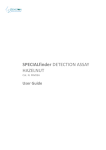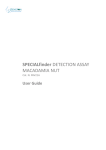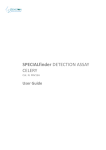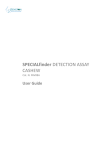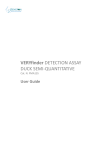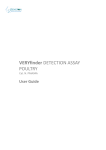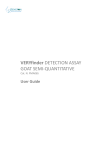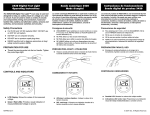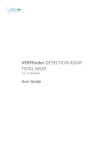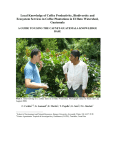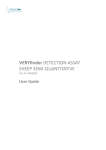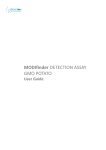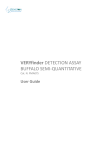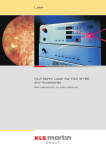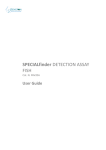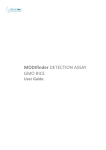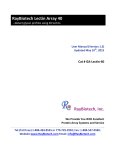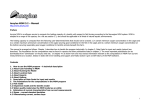Download PAV02A SPECIALFinder Peanut User_Manual
Transcript
SPECIALfinder DETECTION ASSAY PEANUT Cat. N. PAV02A User Guide 1 - Introduction Food allergies are an adverse immune response to a food protein that are the most common allergic compound. Food allergies are an important concern for human health; in fact, the presence of specific proteins in any food matrix can cause an allergic reaction IgE mediated. Allergic reactions may have a broad spectrum, which varies on the basis of the individual sensitivity thus generating in some cases severe anaphylactic reactions. Indeed, food correct labeling is of great importance to inform consumers about presence of any allergic substance other than achieve a high level of health protection. Unfortunately, although known allergens can be included in the product (and in the product label) by the food producer, potentially hazardous allergenic residues/contaminants can be present as result of common industrial practices. Cross-contamination between raw materials, production lines or equipment, is a common cause of unwanted allergen transfer between products intended for different scopes. For all these reasons, developing a detection method for allergic substances ensures customers protection in accordance with food labeling regulations. The SPECIALfinder Peanut Detection Assay provide the user with a simple and reliable procedure for the detection of DNA related to species potentially allergenic, in food and feed matrices as well as swabs. Such a detection is an Indirect Proof of the potential presence of the Peanut proteins into the matrix, being proteins the real allergens. This assay utilizes the polymerase chain reaction (PCR) to amplify a genetic target typical of the allergenic species. PCR technique can typically detect up to 1-10 copies of the target sequence but the real detection/quantification limit depends on industrial processing degree, sample matrix, DNA extraction and, lastly, on the DNA content of the sample. Genome size of the complex samples under investigation can deeply impact the Limit Of Detection (LOD) also, in addition it does exist a theoretical LOD you cannot go below, given an advised maximum load between 2 and 4 ng DNA/µl reaction mix. Generon in-house validation: the LOD has been calculated as copy number by means of ddPCR (Droplet Digital PCR), a novel technique capable to count physically the copy number of a selected amplifiable target. With SPECIALfinder Peanut an average count of 5-10 copies was obtained. DNA was extracted using Generon ION Force DNA Extractor FAST (Cat. N. EXD001). The LOD for this assay was experimentally determined between 1 and 0.5 ppm and depends on sample matrix, processing grade, DNA preparation and DNA content. User guide - SPECIALfinder Peanut Detection Assay - Rev 1 26/11/2014 2 2 - SPECIALfinder Peanut Detection Assay When used along with GENERase PLUS Mastermix (Cat. N. ENG002) this Real-Time PCR assay detects a specific DNA sequence in the DNA of Peanut in less than 1.5 hours. The amplification of the target sequence is measured by the use of a specific fluorescence-labeled probe (FAM). 2.1 - Assay Content Box 50 reactions N. vials Volume (μl) 250 Box 100 reactions N. vials Volume (μl) SPECIALfinder OLIGO Mix * (OLIGOS and Probe pre-blended mix) 1 2 250 Positive Control 1 85 2 85 Negative Control 1 200 1 200 * reagents are supplied with a 5% of extra volume. We suggest to use SPECIALfinder Peanut Detection Assay along with the following Polymerase Enzyme Ready-to-use mastermix: GENERase PLUS Mastermix (Cat. N. ENG002). When using this GENERase PLUS an additional detection channel (HEX) becomes available to detect the Internal Amplification Control (IAC) to excluding false negative results due to a PCR inhibition. 2.2 - Storage & Expiry information Expiry date: see date on the packaging, product validity refers to the product kept intact in its original packaging. Protect reagents from light exposure as far as OLIGO Mix reagents are photosensitive. Store frozen. User guide - SPECIALfinder Peanut Detection Assay - Rev 1 26/11/2014 3 3 – Materials and equipments needed 3.1 – Extraction(1) Material/Equipment Source Extraction Kit Generon ION Force DNA Extractor FAST (Cat. N. EXD001) Chemicals: n-esane Lab Suppliers Tubes, 50 ml and 15 ml Generon or other Lab Suppliers DNAse/RNAse Free Water Generon or other Lab Suppliers Vortexer Generon or other Lab Suppliers Benchtop Centrifuge for 50 ml Tubes Generon or other Lab Suppliers Thermal Water Bath or Block Generon or other Lab Suppliers Pipette sets Generon or other Lab Suppliers Pipette tips (Barrier) Generon or other Lab Suppliers Tube rack for 1.5 ml tubes Generon or other Lab Suppliers 2.0 and 1.5 ml micro-tubes Generon or other Lab Suppliers Micro centrifuge for 1.5-2.0 ml micro-tubes Generon or other Lab Suppliers DNA Extraction VACUUM BOX + Vacuum pump or Venturi meter Generon or other Lab Suppliers Each step of sample preparation (grinding, transferring, weighing, etc.) must be done according to GLP so that chance of cross-contamination between samples is minimized. It is recommended to use disposable equipment when possible. If the food samples are not in a powdered or granular form, they should be processed (grinded or blended) before DNA extraction. The majority of DNA extraction methods supports from 20 to 50 mg of starting material. Generon ION Force DNA Extractor FAST (Cat. N. EXD001) allows processing up to 20 grams of starting material in order to maximize sample’s lot representation. Once the sample has been pulverized/homogenized, it can be weighed and the appropriate amount extracted according to DNA extraction method selected. Refer to manufacturer user manual for extraction procedure details. 3.3 – Detection via Real-Time PCR Material/Equipment Real-Time PCR System (2) Source Generon or other Lab Suppliers Specialfinder Peanut Detection Assay Generon (Cat. N. PAV02A) GENERase PLUS Mastermix Generon (Cat. N. ENG002) Optical Adhesive Seal and Optical reaction plate or Optical Caps and Strips Generon or other Lab Suppliers Micropipette sets Generon or other Lab Suppliers (1) Equipment necessary only when ION Force DNA Extractor FAST (Cat. N. EXD001) is used. (2) The assay can be used with Biorad CFX and MiniOpticon, Stratagene MxSeries, ABI 7300-7500-7900-StepONE-StepONE Plus, Light Cycler 480, Eppendorf realplex, Rotor-Gene Q etc. The assay is not compatible with Roche Light Cycler I and II. User guide - SPECIALfinder Peanut Detection Assay - Rev 1 26/11/2014 4 4 – Real-Time PCR detection 4.1 – Reaction setup I. Allow the reagents to thaw (GENERase PLUS Mastermix, SPECIALfinder OLIGO MIX, Positive Control and Negative Control). Vortex tubes when thawed and spin to collect contents at the bottom of the vial. II. Mix 250 µl of SPECIALfinder OLIGO Mix with 500 µl of GENERase PLUS Mastermix to prepare SPECIALfinder Working Mastermix (WMX). III. Vortex briefly and spin down in order to homogenize the mix. IV. Transfer 15 µl of WMX into each well. V. Add 5 µl of Negative Control into wells acting as negative control. VI. Add 5 µl of each sample into wells testing the unknown samples. VII. Add 5 µl of Positive Control into wells acting as positive control. VIII. Close wells and ensure no bubbles are present at the bottom of the wells. IX. Spin briefly optical PCR tubes or plates. 4.2 – Instrument setup With GENERase PLUS Mastermix set the following parameters on your thermocycler: I. Total Reaction volume: 20 µl II. Fluorophores/Quenchers: Target Peanut (FAM/BHQ1-NFQ); Internal Amplification Control (HEX/BHQ1-NFQ). Depending on your thermocycler, you can replace HEX detector in the plate setting with VIC or JOE in case your own Real Time Platform does not possess the HEX reading channel. III. Thermal profile: Step T (°C) Duration Loops UNG 50 2 min 1 Taq Activation 95 10 min 1 DNA Denaturation 95 15 sec Annealing/Extension + Plate Reading 60 60 sec 45 User guide - SPECIALfinder Peanut Detection Assay - Rev 1 26/11/2014 5 5 – Data Interpretation Results evaluation must be done according to the analysis software recommended by the Real-Time PCR instrument manufacturer. After performing PCR, each individual sample is analyzed through the instrument software to produce a Cq value (quantification cycle) for each reporter dye. These values are used to determine the presence (Qualitative Test) of allergen into the sample. See below an example of the graphics obtained for a positive (Fig. A) and a negative (Fig. B) control, respectively for the allergen target amplification (blue line) and for the IAC amplification (green line). HEX FAM HEX A B After setting the baseline, the analysis outcome should be evaluated following the indications below. If the following conditions are met: TEST Peanut (FAM ) Internal Amplification Control (HEX) Positive Control + + Negative Control - + TEST Peanut (FAM ) Internal Amplification Control (HEX) Positive Sample + +/- Negative Sample - + Invalid Sample (inhibited) - - Then the possible results for any sample are: In case of inhibition DNA isolation and purification for the sample need to be improved or you may need to dilute your sample before performing a new test. Refer to the Troubleshooting paragraph (section 8) for further suggestions. 6 – Inclusivity Panel Species tested for inclusivity Peanut (Arachis hypogaea) User guide - SPECIALfinder Peanut Detection Assay - Rev 1 26/11/2014 6 7 – Exclusivity Panel The following DNA extracts showed no amplification curve in a 20 μl total reaction volume: Meat Beef (Bos taurus) Goat (Capra hircus) Rabbit (Oryctolagus cuniculus) Buffalo (Bubalus bubalis) Horse (Equus caballus) Sheep (Ovis aries) Donkey (Equus asinus) Poultry (Gallus gallus domesticus) Swine (Sus scrofa domesticus) Duck (Anas spp.) Quail (Coturnix coturnix) Turkey (Meleagris gallopavo) Wild boar (Sus scrofa) Crustaceans and Molluscs Clam (Venus gallina) Cuttlefish (Sepia officinalis) Norway lobster (Nephrops norvegicus) Prawn (Penaeus vannamei) Hake (Merluccius merluccius) Salmon (Oncorhynchus kisutch) Mussel (Mytilus edulis) Sea bream (Sparus aurata) Squid (Loligo edulis) Tuna (Thunnus albacares) Vegetables Allergens Almond (Prunus dulcis) Durum Wheat (Triticum durum) Mustard (Brassica nigra) Rye (Secale cereale) Barley (Hordeum vulgare) Hazelnut (Corylus avellana) Sesame (Sesamum indicum) Soft Wheat (Triticum aestivum) Celery(Apium graveolens) Kamut (Triticum turgidum) Oat (Avena sativa) Soybean (Glycine max) Cashew (Anacardium occidentalis) Lupine (Lupinus albus) Pecan Nut (Carya illinoinensis) Spelt (Triticum monococcum) Brasilian Walnut (Bertholletia excelsa) Macadamia Nut (Macadamia integrifolia) Pistachio (Pistacia vera) Walnut (Juglans regia) Other Ananas (Ananas comossus) Cocoa (Theobroma cacao) Mandarine (Citrus reticulata) Plum (Prunus domestica) Apple (Malus domestica) Coconut (Cocos nucifera) Mushroom (Agaricus campestris) Pomelo (Citrus maxima) Apricot (Prunus armeniaca) Corn (Zea mays) Olive (Olea europaea) Potato (Solanum tuberosum) Banana (Musa acuminata) Cucumber (Cucumis sativus) Onion (Allium cepa) Radish (Raphanus sativus) Basil (Ocimum basilicum) Broccoli (Brassica oleracea var. italica) Buckwheat (Fagopyrum esculentum) Eggplant (Solanum melongena) Orange (Citrus aurantium) Rapessed (Brassica napus) Fennel (Foeniculum vulgare) Parsley (Petroselinum crispum) Rice (Oryza sativa) Garlic (Allium sativum) Peach (Prunus persica) Strawberry (Fragaria x ananassa) Carrot (Daucus carota) Grapefruit (Citrus × paradisi) Pear (Pyrus communis) Sunflower (Helianthus annuus) Chard (Beta vulgaris var. cicla) Grapes (Vitis vinifera) Peas (Pisum sativum) Tomato (Solanum lycopersicon) Cherry (Prunus avium) Green Beans (Phaseolus vulgaris) Pepper (Capsicum annuum) Zucchini (Cucurbita pepo) Chestnut (Castanea vulgaris) Lemon (Citrus limonia) Pine Nuts (Pinus pinea) User guide - SPECIALfinder Peanut Detection Assay - Rev 1 26/11/2014 7 8 – Troubleshooting I. II. Concomitant no target or IAC amplification, or amplification plots grossly abnormal. Possible causes and corrective actions: • An excess of DNA in the target might inhibit the reaction and IAC may be affected due to an excess of DNA and/or PCR inhibitors. Test samples diluted 1:10 and 1:100. Please, use DNase/RNase Free Water to prepare dilutions. • Inadequate sealing of optical caps/film caused sample evaporation. Redo the analysis using proper tools and proper optical caps/film to secure perfect sealing. • Did not use the proper consumables. Redo the analysis and use only optical grade 96-well plates and optical adhesive seal or optical 8-well strips and caps. • Samples were not properly prepared. Remake the sample DNA preps. Ensure that the DNA extraction method is properly performed. Positive Control reactions failed to amplify, but other reactions appear correct (e.g. the IAC is amplified): • Positive Control DNA was not added to the reaction wells. If other reactions look normal, there may be no need to repeat the run. III. Negative Control reactions are positive: • Contamination of the Negative Control vial or the SPECIALfinder PCR mix with SPECIALfinder-positive DNA. Use more care to prevent contamination while handling assay reagents and setting up assays. In case support is needed contact Generon at: [email protected] 9 – Disclaimers The product is intended for research use only. Generon makes no warranty of any kind, either expressed or implied, except that the materials from which its products are made of standard quality. If any materials are defective, Generon will provide a replacement product. Generon shall not be liable for any damages, including special or consequential damage, or expense arising directly or indirectly from the use of this product. Please do not interchange components between assays of different lot numbers. This assay is designed to be used by laboratory personnel following the common molecular biology precautions. User guide - SPECIALfinder Peanut Detection Assay - Rev 1 26/11/2014 8 Quick Reference Guide Product Line: Part Number: Type: Storage: Execution time: Expiry date: Page 1 SPECIALfinder PAV02A Qualitative Frozen about 120 minutes see date on the packaging, product validity refers to the product kept intact in its original packaging and constantly under suitable temperature conditions as mentioned above. Assay Box Content Box 50 reactions N. vials Volume (μl) Box 100 reactions N. vials Volume (μl) SPECIALfinder OLIGO Mix (OLIGOS and Probe pre-blended mix) 1 250 2 250 Positive Control 1 85 2 85 Negative Control 1 200 1 200 All reagents are supplied with a 5% of extra volume. Not Provided Article: GENERase PLUS Mastermix (Cat. N. ENG002) or equivalent. Reaction Set-Up Protect reagents from light exposure as far as OLIGO Mix reagents are photosensitive. Before setting the analysis, we strongly advise to leave the reagents to warm up at room temperature. Vortex briefly OLIGO mix, afterwards spin to collect contents at the bottom of the vials. Spin GENERase PLUS Mastermix before opening it. Prepare SPECIALfinder WORKING Mastermix by adding 250 μl of SPECIALfinder OLIGO Mix into each tube prefilled with 500 μl of GENERase PLUS Mastermix (Cat. N. ENG002) in order to obtain a single volume of 750 μl of SPECIALfinder WORKING Mastermix. Vortex briefly SPECIALfinder WORKING Mastermix with the aim of homogenizing the mix and excluding MgCl2 gradient that could impair the results. Spin to collect contents at the bottom of the vial (Note: label GENERase PLUS vials with target name after OLIGO Mix addition). Vortex briefly Positive Control and samples before proceeding further, spin to collect contents at the bottom of the vial. Transfer SPECIALfinder WORKING Mastermix and samples into the plate as follows: Reagents per well Unknown Sample Positive Control Negative Control SPECIALfinder WORKING Mastermix Final Volume Volume 5 μl 15 μl 20 μl Detector Setup Target Peanut IAC (Internal Amplification Control) Reporter Dye FAM HEX (*) Quencher Dye BHQ1-NFQ BHQ1-NFQ (*)According to your thermocycler you can replace HEX detector in the plate setting with VIC or JOE in case your own Real Time Platform does not possess the HEX reading channel. User guide - SPECIALfinder Peanut Detection Assay - Rev 1 26/11/2014 9 Quick Reference Guide Page 2 Thermal cycling Step UNG Taq Activation DNA Denaturation Annealing/Extension + Plate Reading T (°C) 50 95 95 60 Duration 2 min 10 min 15 sec 60 sec Loops 1 1 45 The thermal profile presented above was optimized for GENERase PLUS Mastermix (Cat. N. ENG002). Results analysis If the following conditions are met: TEST Peanut (FAM) Internal Amplification Control (HEX) Positive Control + + Negative Control - + TEST Peanut (FAM ) Internal Amplification Control (HEX) Positive Sample + +/- Negative Sample - + Invalid Sample (Inhibited) - - Then the possible results for any sample are: In case of inhibition DNA isolation and purification for the sample need to be improved or you may need to dilute your sample before performing a new test. Refer to the Troubleshooting paragraph, section 8 in the User Guide, for further suggestions. Warning and Precaution Please, do not interchange components of assays with different lot numbers. This assay is designed to be used by laboratory personnel following the common molecular biology precautions (GLP). Disclaimer Generon s.r.l. guarantees the buyer exclusively concerning the quality of reagents and of the components used to produce the Assay. Generon S.r.l. is not responsible and cannot anyway be considered responsible or jointly responsible for possible damages resulting from the utilization of the product by the user. The user consciously and under his own responsibilities decides for the utilization purposes of the product and uses it the way he considers most suitable in order to reach his goals and/or objectives. Generon S.r.l. is not responsible for the data resulting from the use of the products, for the utilization that the user independently decides to make of them or for the damages possibly resulting from the disclosure or transmission of the data themselves to third parties under any form or circumstance. This clause is automatically accepted by the user when purchasing the products. The patent for performing PCR is held by Hoffmann/La Roche. Authorization to use PCR can be obtained on licence from Hoffmann-LaRoche. The product, equipment and information included in the assay consists of assembled and reagents. The licence and licence and authorisation for PCR use are not included in the assay. The user is responsible for setting prefixed goals, choosing whether or not to perform the PCR reaction and to apply for register his own licence. The use assay is designed for the services supply, quality control or any other application that is not exclusively an internal company’s research and requires a specific licence for PCR use. This PCR use licence to supply a service on food analysis field has to be requested directly from Applied Biosystems”. This assay requires the use of Taq Polymerase enzyme. The product was internally tested by our quality control. Any responsibility is waivered if the warranty of quality control does not refer to the specific product. The user is personally responsible for data that he will obtained and/or he will supply to third parties using this assay. Once the sealed package is open the user accepts all the conditions without fail; if the package is still sealed the product can be returned and the user can be refunded. User guide - SPECIALfinder Peanut Detection Assay - Rev 1 26/11/2014 10










